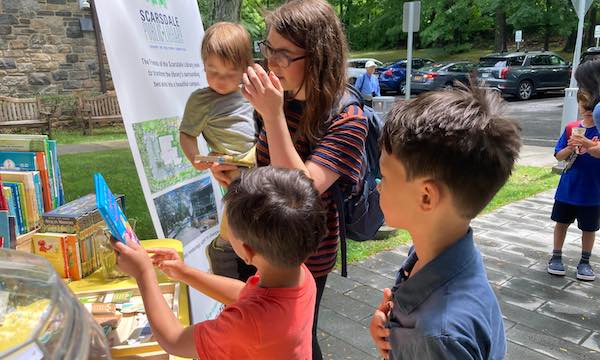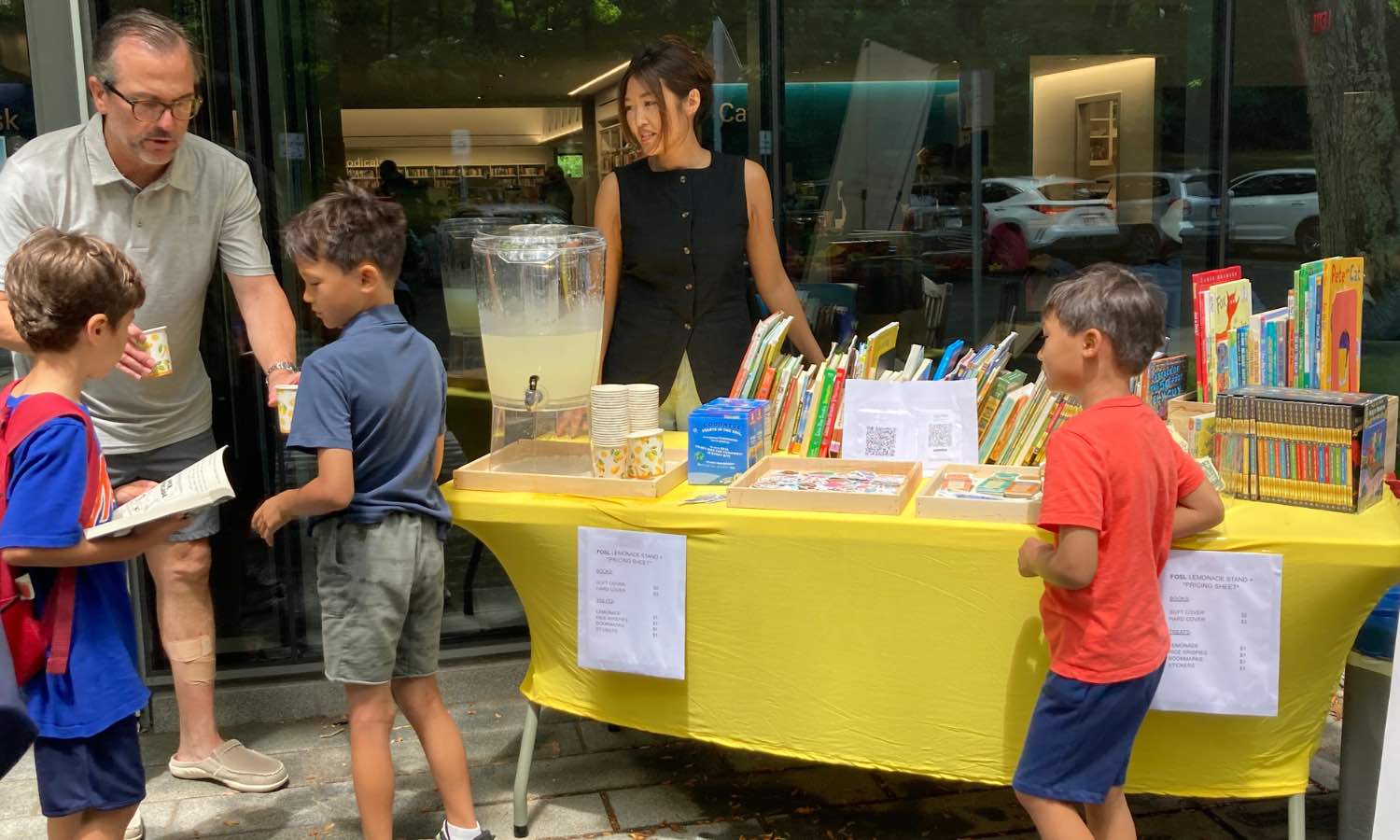Young Philanthropists Raise Funds for the Friends of the Scarsdale Library
- Details
- Written by: Wendy MacMillan
- Hits: 1680
 Local boys held a “sweet” Fundraiser for the Friends of the Scarsdale Library! On Saturday, July 13th, brothers Costas (7) and Philip Konstantoulakis (5) sold lemonade and books to raise money for the FOSL’s Landscaping Project.
Local boys held a “sweet” Fundraiser for the Friends of the Scarsdale Library! On Saturday, July 13th, brothers Costas (7) and Philip Konstantoulakis (5) sold lemonade and books to raise money for the FOSL’s Landscaping Project.
Mom Julia Park explained, “Costas and Philip love going to the Scarsdale Library. One day Costas noticed the FOSL poster about the Landscaping project and said that he wanted to help their cause. He was so motivated, that night he started brainstorming ideas and came up with the idea of donating his used books and selling lemonade.”
On the hot, steamy day the boys will offer cold, refreshing lemonade, snacks, stickers and an assortment of gently used books for sale. All proceeds were donated to the Friends of the Scarsdale Library.
Presidents of the Friends of the Scarsdale Library said, “Scarsdale has a deep history of philanthropic residents, and we are delighted to see and encourage it in our youngest residents. It is so gratifying to see our community members engaged in the plans to transform the library’s campus into a parklike destination for all our residents to enjoy. We are confident Costas and his peers will enjoy the changes for years to come."
Library Director, Beth Bermel, was also delighted to hear that the library had such an impact on Costas and his brother Philip. “It is truly heartwarming to see young people so invested in their community library. The Friends are lucky to have these enterprising youth supporting their efforts, and we are grateful for such a supportive community, including the inspiring Konstantoulakis family.”The Friends work in partnership with the SPL team to bring relevant and inspired content to Scarsdale by sponsoring book discussions with popular authors, underwriting art shows and purchasing the latest technology. Donations are accepted year-round, and funds are used for a variety of programs throughout the year, including the chess programs Costas and Philip enjoy attending.
The Library in the Park Campaign - the inspiration for the fundraiser - will make more outdoor space available for open-air programming, for reading and study, for Scarsdale children and adults alike. The Campaign has nearly achieved its fundraising goal and will be wrapping up and unveiling detailed drawings this Fall.
To make a donation to the Friends, reach out to foslpresident@gmail.com.
Letters Regarding the Duck Pond and Idling Cars
- Details
- Written by: Joanne Wallenstein
- Hits: 2000
 The Duck Pond in Heathcote is covered in algae.We received two letters this week. One regarding the Heathcote Duck Pond and another about idling cars.
The Duck Pond in Heathcote is covered in algae.We received two letters this week. One regarding the Heathcote Duck Pond and another about idling cars.
Here they are:
Dear Sirs:
I and my family have lived in the Heathcote section of Scarsdale for over 60 years. I would prefer to submit this letter anonymously but the facts discussed below should be obvious to all Scarsdale residents:
My family and neighbors have all noted the condition of the Heathcote Duck Pond has seriously deteriorated since the COVID pandemic in 202. The water is now covered with a film of algae, with a foul order and is no longer an attractive destination for residents. For decades there were 2 or 3 water fountains that every spring, summer and fall sprayed and circulated water and were illuminated at sunset. This little park was a beautiful setting for locals to walk or drive to oin the evening and weekends and was often a backdrop for pictures of wedding parties, etc. We would also see many ducks and other birds in the park. This is not possible today because of its swamp-like decayed and deteriorating condition.
I was astonished to learn this property is privately owned and the Village has no authority to maintain it in the dignified and appropriate manner so appropriate as the center of our “Village in a Park.” The Village advised the pond and surrounding land are owned by The Heathcote Association, a private entity.
I request that the appropriate Scarsdale government officials inspect this pond and land and please have the lawful owner immediately clean and restore if and maintain it, in perpetuity, to its pre-pandemic condition, consistent with our community’s values.
With much appreciation,
A Heathcote Resident
(Note: Scarsdale10583 received a similar communication in July 2022. At the time, we reached out to the President of the Heathcote Association who said the following.)
“Yes, the Heathcote Association does own the pond and maintained it for years. But now there is considerable sediment on the bottom and it needs to be dredged. If not, the sediment will clog the fountains (bubblers) and break them."
He explained that the Association has been looking into doing the dredging but during COVID it was difficult to get people out to do the work. Furthermore, he said that the primary cause of the sediment is that the Village waterways empty into the pond. Therefore, they have been working with the Village Engineering Department and believe that the Village has an obligation to help the Association with the project and the costs. They don’t believe it is only the Association's responsibility as the Village has been using the pond as part of their water system and people from all over Scarsdale use the pond.
So for now, the fountains will remain off until the dredging can be done.”
From Susan Levine regarding cars:
Today was a lovely day in Scarsdale...75 degrees and breezy. Despite that I saw several cars disobeying the “No Idling for Over Three Minutes Westchester County Law,” including a huge black Lincoln Navigator with the occupant just sitting inside on her phone for more than 20 minutes creating huge amounts or air pollution right in front of Bagel Power. Scarsdale residents need to help to fight air pollution by obeying the law and turning off their car engines when they are parked and not driving.
Graduation Tributes
- Details
- Written by: Joanne Wallenstein
- Hits: 1412
It's graduation season, and kids are moving up in elementary school and middle school, and graduating from high school, college and graduate school. Here are tributes to the grads of parents and grandparents at Advocate Brokerage and Houlihan Lawrence in Scarsdale. Hat's off to everyone who is moving up and moving on.


Daniel Kurzner Weds Tessa Shapiro in Williamsburg
- Details
- Written by: Joanne Wallenstein
- Hits: 2862
 Daniel Ethan Kurzner (SHS ‘09) and Tessa Leigh Shapiro were married on May 11, 2024 at Weylin in Williamsburg, Brooklyn. Tamara Wolfson (SHS ‘07), a hazzan (cantor) and the bride’s cousin, officiated the Jewish wedding ceremony.
Daniel Ethan Kurzner (SHS ‘09) and Tessa Leigh Shapiro were married on May 11, 2024 at Weylin in Williamsburg, Brooklyn. Tamara Wolfson (SHS ‘07), a hazzan (cantor) and the bride’s cousin, officiated the Jewish wedding ceremony.
The couple began dating in February 2018, when Tessa’s cousin & Dan’s friend Sarah Wolfson Butler (SHS ‘09), thought they would be a great match. Their relationship has been filled with great restaurants, adventurous travels, weekends on the North Fork of Long Island, lots of ice cream and bonding over their shared fandom for the New York Giants and the Michigan Wolverines.
In December 2022, Dan’s sister-in-law Julia Fishman (SHS ‘06) came up with the plan to throw a fake birthday party for herself to save the date for a surprise proposal. Dan proposed in Astoria Park, which is where the couple said “I love you” to each other for the first time.
The groom, 32, is a Strategy and Operations Manager at Google. He graduated from Scarsdale High School in 2009 and from Washington University in St. Louis in 2013, and earned his Masters of Business Administration from the University of Michigan Ross School of Business in 2020. Dan is the son of Wayne Kurzner, who is a personal injury lawyer in New York.
The bride, 30, is a Manager of Trust and Safety Partnerships at YouTube. She graduated from The Dalton School in New York City in 2012 and from the University of Michigan in 2016 with a degree in Biopsychology, Cognition and Neuroscience. Tessa is the daughter of Richard Shapiro and Lynn Usdan Shapiro. The bride’s father is a Senior Advisor at Excel Sports Management. The bride’s mother is the Senior Vice President of Ethics and Compliance and Corporate Affairs at LVMH.
Give Your Feedback on the Condition of Scarsdale's Fields, Courts, Parks and Playgrounds
- Details
- Written by: Joanne Wallenstein
- Hits: 1811
 Though residents have been asking for field improvements, additional fields and updated recreational facilities for years, with so many sites and so many needs, it was difficult for the Village of Scarsdale and the Scarsdale Schools to assign priorities for what should be done first.
Though residents have been asking for field improvements, additional fields and updated recreational facilities for years, with so many sites and so many needs, it was difficult for the Village of Scarsdale and the Scarsdale Schools to assign priorities for what should be done first.
In order to get an inventory of the work that needs to be done and a wish list for improvements, Scarsdale Village and the Scarsdale School District retained consultants from CHA to thoroughly analyze the issue. Since some fields, courts, parks and playgrounds are the property of the Village and others are owned by the schools, the two entities joined forces to tackle the problem.
As a first step, CHA visited each facility, accompanied by personnel from the Village and the schools. They studied each site and did an analysis of the condition of the fields and amenities. Consultants held focus groups with village and school staff and then conducted a series of interviews with stakeholders from the independent sports organizations that use the fields as well as representatives from high school booster organization Maroon and White.
Using the feedback from those session, they created poster size aerial views of each site and identified issues on these boards so that the public could see areas that need improvement. You can see these site plans here:
On Thursday night May 23 the community was invited to the first of two public outreach sessions with the consultants. They explained that they will continue to solicit public input and use what they learn to define priorities for work on these facilities.
The large posters of each facility were placed on tables around the room – and participants were asked to use stickies and pens to mark what they feel is needed or what they would like to see improved – at each site.
For those who did attend the meeting, a google sheet has been set up online and you can use it to submit your feedback here:
Asked what some of the issues were that had already been identified, the consultants said:
Most of the field have drainage issues.
Some feel that field allocation for some sports is inadequate.
Consultants heard that there are not enough outdoor basketball courts and some would like an indoor court facility – or a gym for general indoor use.
Some sites lack amenities.
In terms of resident requests, consultants heard:
Some think the Scarsdale Middle School fields have potential to be repurposed.
People asked for equitable distribution of spending for genders and sports.
People want a clear road map to implement the changes.
The consultants said they will be looking for the most efficient uses of funding so that the most people will benefit from the work. The goal is to make a road map for work on these sites in the years to come.
Take a look at the presentation and give your input here.










